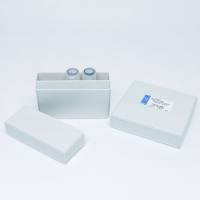Guidelines for Egg and Oocyte Harvesting in Xenopus laevis
互联网
properly performed by technically proficient research personnel, female Xenopus are not harmed by the egg stripping procedure and can be used again after a recovery period of 3-6 months.
Stage I-VI oocytes are obtained by surgical laparotomy. Multiple surgeries on a single animal may be justified considering the reduction in the total number of animals used over the long term. However, the total number of animals used must be considered relative to the pain or distress experienced by an individual animal.
1. The total number of laparotomies should be limited and will depend on the condition of the animal and quality of the oocytes as well as the life span of the animal and the duration of egg production. Up to five recovery surgeries (the 6th would be terminal)per animal are acceptable. Additional survival surgeries should have approval of the individual ACUC.
2. Surgeries should be performed by trained personnel using appropriate anesthesia such as tricaine methane-sulfonate (MS-222). Surgeries should be done as aseptically as practical including the use of sterilized instruments and gloves.
Instruments should be sterilized by autoclaving or using a glass-bead sterilizer. The use of cold sterilants should be avoided so that these potentially toxic chemicals are not inadvertently introduced into the surgical site or onto permeable amphibian skin.
3. The use of surgical drapes and preparation of the surgical site remains controversial for aquatic species. The use of a sterile drape and preparation of the surgical site with dilute povidone iodine or chlorhexidine solution has been recommended (DP O’Rourke and TW Schultz, Biology and Diseases of Amphibians, Laboratory Animal Medicine, 2nd Edition, Academic Press, 2002). However, another source notes:“Fish skin is easily damaged by alcohols and surgical scrub solutions, and the exuberant response of the mucus-producing glands to that damage far exceeds any potential benefits derived from using them.” (MK Stoskopf, Surgery, Fish Medicine,W.B. Saunders Company, 1993). The use of these chemical agents may disrupt the normal skin flora of the patient and the constant mucous production of Xenopus skin makes any sterilization effort transient. When chemical surgical preps are used, they should be limited to the immediate area around the incision site.
Similarly, arguments have been presented regarding the use of surgical drapes.
Drapes may be useful to keep mucus from getting on instruments and suture material, and can be moistened to keep skin from drying during surgery. However,amphibian skin can be easily damaged and paper drapes that become wet pose no barrier to bacteria. NIH veterinarians report that the incidence of clinical complications following surgical oocyte harvesting is rare.
The decisions regarding the use of surgical drapes and performing single surgical site skin preps are left to the discretion of the NIH scientist in consultation with his/her IC veterinary staff and with approval by the ACUC.
4. Single housing or small group housing for several days after surgery should be considered as part of the post surgical care of animals undergoing laparotomy.
Frogs should be monitored daily during this period for appetite as well as for any complications such as dehiscence or infection. Such adverse effects would be reasons for immediate euthanasia.
5. Adequate recovery time should be allowed between laparotomies. The investigator can alternate oocyte collection between left and right ovaries and consider rotation of frogs so that the interval between surgeries in any individual is maximized.
Recovery time of less than one month should have approval of the individual ACUC.
Approved by ARAC, 6/12/96.
Revised - 2/10/1999
Re-approved - 10/10/2001
Revised - 4/13/2005








